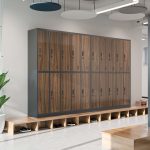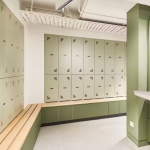Selecting the right steel lockers for schools is critical to ensuring student safety, optimizing space, and maintaining long-term durability. With diverse needs across campuses—from elementary schools to universities—administrators must consider factors such as security, customization, and cost-effectiveness. Below is a structured guide to help schools make informed decisions.
1. Prioritize Safety and Security
Safety is non-negotiable. Opt for lockers with anti-pry designs, reinforced edges, and robust locking mechanisms. Popular choices include:
- Key locks: Simple and cost-effective but require key management.
- Combination locks: Eliminate key-loss issues and promote student responsibility.
- Electronic locks: Offer advanced features like remote access control, audit trails, and integration with school security systems.
For added security, choose lockers with ventilation holes to prevent odor buildup while maintaining visibility to deter hidden contraband.
2. Assess Durability and Maintenance
Schools demand low-maintenance solutions. Look for:
- Gauge of Steel: The lower the gauge number, the thicker the steel. 16 to 18-gauge steel is the industry standard for heavy-duty educational environments.
- Powder-coated steel: Resists scratches, corrosion, and fading, even in high-traffic areas.
- Heavy-duty hinges: Ensure smooth operation over years of use.
- Modular designs: Allow easy replacement of damaged parts without overhauling entire units.
Avoid lockers with exposed sharp edges or flimsy materials that degrade quickly.
3. Optimize Space with Customizable Configurations
Space constraints vary by school. Consider:
- Tier options: Single-tier lockers (for hanging coats) or multi-tier (2–5 tiers) to maximize vertical space.
- Dimensions: Standard heights range from 180cm to 210cm, with widths of 30cm–45cm per compartment. Custom sizes can accommodate specific needs, such as sports equipment storage.
- Layout flexibility: Stackable or side-by-side designs adapt to hallways, gyms, or classrooms.
- Accessories: Consider adding internal shelves, hooks, or book catchers (a small shelf inside the door) to help students stay organized.
4. Enhance Functionality with Add-Ons
Modern steel lockers can integrate practical features:
- Built-in charging ports: For students to power devices securely.
- Adjustable shelves: To accommodate items of varying sizes.
- Locker benches: Combine seating with storage in gym areas.
- Color coding: Use different hues for grade levels or departments to improve organization.
5. Balance Cost and Long-Term Value
While budgets vary, prioritize value over upfront cost. Cheaper lockers may incur higher replacement or repair expenses over time. Invest in:
- Warranties: Seek 5–10-year guarantees covering structural integrity and locking systems.
- Energy efficiency: If using electronic locks, choose low-power models to reduce operational costs.
- Scalability: Designs that allow incremental additions as student populations grow.
6. Comply with Regulations and Accessibility Standards
Ensure lockers meet local safety codes (e.g., fire resistance, ventilation requirements) and ADA (Americans with Disabilities Act) guidelines. Features to consider:
- Lower compartments: For students in wheelchairs.
- Easy-grip handles: For users with limited dexterity.
- Clear labeling: Braille or large-print labels for visually impaired students.
7. Involve Stakeholders in the Decision Process
Gather input from:
- Students: Test prototypes for usability and comfort.
- Staff: Identify pain points (e.g., locker jams, maintenance issues).
- IT teams: If integrating smart locks, ensure compatibility with existing systems.
Conclusion
Choosing steel lockers for schools requires a holistic approach that balances security, durability, and adaptability. By prioritizing student needs, future-proofing designs, and leveraging customizable features, schools can create a safe, organized, and efficient storage environment. Invest wisely today to avoid costly upgrades tomorrow.
Key Takeaways:
- Safety and durability are paramount.
- Customization enhances functionality and space utilization.
- Long-term value outweighs initial savings.
- Compliance and accessibility ensure inclusivity.
By following this guide, schools can select steel lockers that stand the test of time while supporting their unique educational mission.





